► New electric Ford Explorer to cost £39,875
► SUV is the first EV to drive around the globe
► Final spec details, including 374-mile max range
Ford’s Explorer electric SUV will cost £39,785 and go on UK sale in August 2024 – about nine months behind schedule. But the Blue Oval has used the delay to good effect, updating the battery tech to boost DC charging and range – the bigger battery variant can cover up to 374 miles, which Ford reckons is class-leading for now.

It also spent the past six months driving prototypes around the world, with travel influencer Lexie ‘Limitless’ Alford at the wheel. The Explorer is the first electric car to achieve that feat, visiting some of the world’s key antipodal points and racking up the miles in Europe, Africa, Australia, Asia and South and North America.
The ‘Charge around the Globe’ odyssey covered 30,302.6km (18,830 miles) and ended in Nice, south of France, as Lexie crossed the finish line in her Explorer, flanked by a cavalcade of historic European Fords. Read on for all the spec details.

Visit CAR’s BYD electric cars site and you could win £5000!
Give me more background on the metal Explorer
Ford talks about its ‘can do’ attitude, but it would have been a ‘can’t do’ without Volkswagen – the Explorer is an ID.4 beneath the skin, though overhauled by Ford’s hardware, design and software experts.
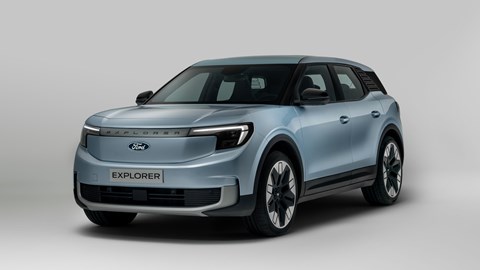
The midsize electric SUV is the first fruit of the firms’ 2019 tech alliance, and the Explorer is a bit smaller than the ID.4: a similarly sized rival is the Kia Niro Electric.
By using Volkswagen’s MEB electric car platform, Ford reckons it cut the development time by two years. Before it added another nine months on again, ostensibly to get VW’s latest Nickel Manganese Cobalt battery tech that meets Europe’s latest sustainability standards.
Explorer: confirmed battery, motor and range specs
Extended range Explorers, costing from £45,875, pack a 77kWh liquid-cooled battery pack for the rear-drive version, while the all-wheel drive version gets 79kWh (usable capacities). A 55kWh pack (gross capacity) will power the standard range car, although Ford is yet to confirm this model’s exact specs.
There are three electric motor options, with either rear-wheel drive or part-time four-wheel drive in the flagship version. Here’s how the specs break down:
STANDARD RANGE
• Usable battery: 52kWh
• Motor: 125kW (168bhp), rear-wheel drive
• Range: 218 miles range (to be confirmed)
• Price: £39,875
• On UK sale: late 2024
EXTENDED RANGE RWD
• Usable battery: 77kWh
• Motor: 210kW (282bhp), rear-wheel drive
• Range and efficiency (Explorer spec): 374 miles, 4.47 miles per kWh
• Range and efficiency (Premium spec): 355 miles, 4.23 miles per kWh
• Price (Explorer spec): £45,875
• On UK sale: available to order now, deliveries August/September
EXTENDED RANGE AWD
• Usable battery: 79kWh
• Motor: 250kW (335bhp), four-wheel drive
• Range and efficiency (Explorer spec): 329 miles, 3.96 miles per kWh
• Range and efficiency (Premium spec): 305 miles, 3.74 miles per kWh
The 250kW flagship Explorer splits its power across both axles, with an asynchronous motor added up front to supply torque during hard driving or on slippery surfaces. In true American spirit, Ford quotes a 1200kg towing capability for this model, or 1000kg for the 210kW 77kWh model.
The most efficient rear-drive car can cover up to 4.47 miles per kWh, while the AWD equivalent is just under 4 miles per kWh.
How fast will she charge, mister?
The Explorer can charge from a 7kW AC home wallbox (or 11kW if you have three-phase electricity), and comes with two capacities for DC ultrarapid charging. The 77kWh battery’s fastest DC charging is pegged at 135kW, while the 79kWh pack can take up to 185kW of fast-charge juice. Both those charging rates are higher than Ford’s initial expectations.
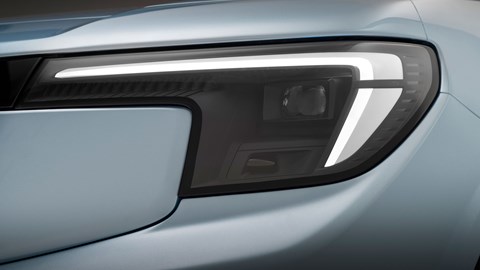
Replenishing the two batteries takes a similar time, going from 10 to 80 per cent in 26 minutes for the 185kW DC capable all-wheel drive car, and 28 minutes to charge the rwd Explorer’s slightly smaller battery. A heat pump, useful for managing cabin climate without draining the battery, will be optional.
How quick is the Explorer, and will it drive like a true Ford?
Ford has also confirmed the Explorer’s acceleration times, and it’s fractionally quicker than comparable ID.4s (which are bigger). The rear-wheel drive Explorer sprints from standstill to 62mph in 6.4secs, with all-wheel drive cutting that to just 5.3secs.
No word yet on the capabilities of the base Ford, but the entry-level, £40,145 ID.4 has a 125kW motor and accelerates from zero to 62mph in 9.0sec.
And can the VW-with-a-new-top-hat drive like a Ford? ‘The springs, dampers and anti-roll bar are all tuned to the Ford philosophy,’ promises engineering manager Thomas Riehm. ‘There’s been a lot of adaptation: the steering and brakes are tailored to the Fordness people are used to.’
The car also gets bespoke Continental tyres. This summer’s test drive will reveal if Ford can soup up MEB’s solid but hardly enthralling dynamics.
An Explorer circumnavigating the globe? How literal!
Lexie Limitless is quite the explorer, having visited the world’s 196 sovereign territories by the age of 22. This expedition was in an electric car capable of up to 374 miles for the rear-wheel drive Extended range version. With the six-month (on and off) trip required over 250 charges in total, refuelling on everything from ultrarapid DC chargers to domestic sockets.
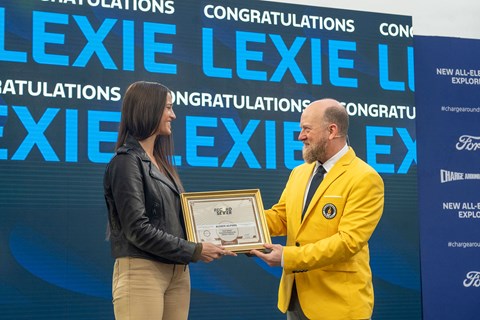
In areas without charging infrastructure, filling the 77kWh battery using a 1.5-2.5kW mobile wallbox could demand stops exceeding 24 hours. Long stints across Chile’s barren Atacama desert proved particularly tense, while periodic grid shutdowns challenged the crew in South Africa and Zimbabwe.
‘Lexie’s journey has been the ultimate test drive for our new Ford Explorer, taking on every kind of weather and road condition, and dealing with just about every charging scenario,’ said Martin Sander, general manager Ford Model e Europe. ‘It embodies the true ‘can do’ spirit of this company.’
Ford electric car plans in detail
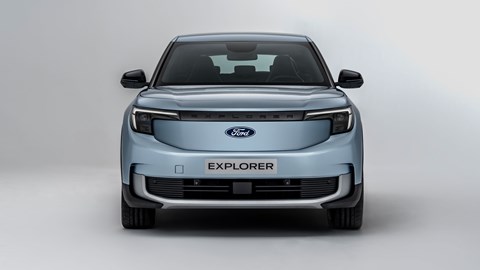
Ford’s new strategy: go electric, be proudly American
Using the Explorer name reflects Ford’s change of strategy. Out go the axed Fiesta and Focus European hatchbacks, in come electric models which trade on Ford’s American roots to make them stand out. So when the project kicked off in mid-2020, the design team knew they were creating an Explorer.
That’s why the car is a distinctly two-box SUV, with ramrod straight lines. Its looks trade any hint of sportiness for strength. The roof is quite horizontal unlike the sloping Volkswagen’s, and the pillars are blacked out to give it a ‘floating’ roof effect, like the big Explorer.
The pillar just behind the rear door has the same ‘sail’ shape as its US cousin’s, but here it’s peppered with translucent silvery grey.

Tell us more about the design and packaging…
The Explorer is a little lower and 12cm shorter than the ID.4: overall, the Ford measures 4.46m long, the reduction coming from a shorter rear overhang. That reduces luggage space by 93 litres, to 450 in total.
The Ford and VW are much the same width and share the same wheelbase, because their battery packs are identical: boosting differentiation would suck up big investment.
So while the batteries, motors, suspension and key dimensions are shared, Ford has designed a unique ‘top hat’ for the MEB platform. The proportions and glasshouse betray the VW underpinnings, even though Ford says it’s pushed back the windscreen.

‘The Explorer has fantastic proportions,’ says Jordan Demkiw (above right) who led the exterior design team and showed CAR around the vehicle in advance of its world debut in March 2023. ‘The wheels have a large overall diameter, there are short overhangs, a relatively long hood and a [slightly] rear-positioned cabin. There’s a good glass to body relationship, it’s a car that sits well on its wheels.’ Alloys span 19 to 21 inches.
A big leap of faith was eliminating current Fords’ trapezoidal grille. ‘We were dwelling on this forever,’ confides Murat Güler, chief designer passenger vehicles. ‘With electric cars, you can take that [engine breathing] element away, but you still want to give the car a strong personality. Some EVs look a bit characterless, like jellybeans!’

What’s the Explorer like inside?
Interior quality and aesthetics take a massive step forward compared with recent Ford’s bleak and cheap cabins. ‘They weren’t because our colour and material designers weren’t as creative as others,’ says Murat Güler.
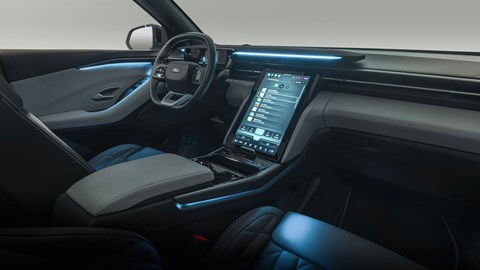
‘Ford has put money into the suspension and other places which consumers can’t see, but enthusiasts feel. That’s maybe one of the reasons we couldn’t go as bold as the French or others.’
The pictured car is an Explorer Premium, but the two-tone dashboard is standard across the range. The lighter grey lower section lifts the ambience, and the horizontal sections – including the discrete vent strip – continue the exterior design theme. There’s no leather option: seats are either part or wholly upholstered in sporty, manmade Sensico.
There are a few parts shared with VW, including the twist-action gear selector (though dropped from adjoining the driver’s display to the steering column), and the fiddly pair of window switches where you have a ‘shift’ key to toggle between front and rear operation.
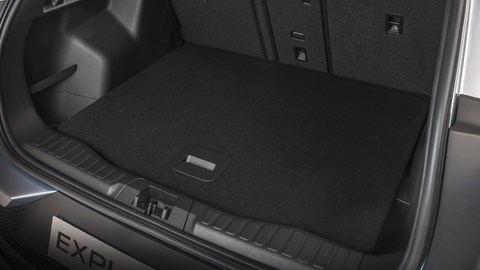
And the Explorer’s USP: some ingenious stowage
The main events are the massive touchscreen and voluminous stowage. The 15-inch screen is mounted in portrait configuration, and gives max real estate for its nav map and widgets. Ford reckons its Apple CarPlay display is the biggest around, which should make it easy to jab on the move. There aren’t physical air-con controls, but the sliders can be permanently displayed at the screen’s base.
Ford’s big innovation is that you can swing the screen through 30 degrees, to find your favourite angle. Push it all the way back to reveal a locker, where you can stash wallet or keys. It’s mechanical for a quick, simple user experience.
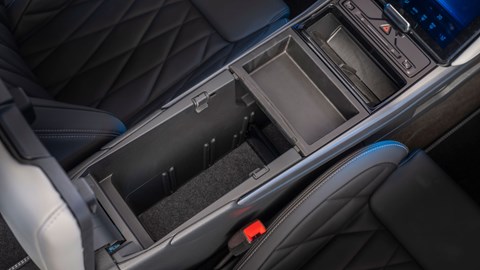
Beneath the armrest lies a MegaConsole (in Ford marketing speak), which can store a laptop or three 1.5-litre drinks bottles: just remove the adjacent cupholders to widen the opening, or if they get in your way. And the cavernous cubby can be segmented with a divider which doubles up as an ice scraper (a nice, Skoda-style touch). All good. But the pulse hardly races when stowage is a car’s biggest USP.
Ford’s new strategy: all electric in Europe by 2030
Ford says it’s investing $50billion (£41bn) in electrification in the next four years. As a result, half of its global sales will be pure electric by 2030, the point when all its European passenger car should be strictly zero emissions.
Ford has struggled for profitability on this continent for years, though it’s resisted the General Motors option of pulling out of Europe altogether. But that’s why Ford, with its far smaller scale than mega-car groups such as Volkswagen or Stellantis, has been forced to do a short-term EV technology deal. A second model, expected to be a coupe version of the Explorer similar to the ID.5’s relationship to the ID.4, will follow in 2024.
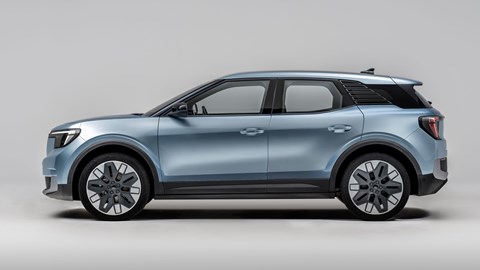
There’s no crime in platform sharing, otherwise all car company CEOs would be behind bars. But the car world feels a poorer place when Ford, which has engineered Europe’s dynamic benchmarks with the Fiesta and Focus hatches, is buying in VW’s MEB electric architecture to underpin its new EVs.
It’s the reversal of 25 years ago, when VW had to headhunt Ford engineers to catch up with the Mk1 Focus’s control blade rear suspension.
Ford Explorer: first verdict
‘The Fiesta and Focus are making way for a new Ford strategy in Europe,’ counters a Ford spokesperson. ‘We’re not going to be the same company that people grew up with, going after volume and playing in every single segment. We’re going to double down on differentiated vehicles that get your pulse racing more.’
So does the Explorer get your pulse racing? Or is it an expedient car lacking true Ford authenticity, or an alluring ownership proposition that grafts a distinctive Ford body onto well-established Volkswagen engineering? Let us know in the comments below. How you – and buyers – respond will be fascinating to watch…